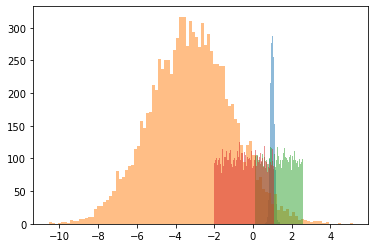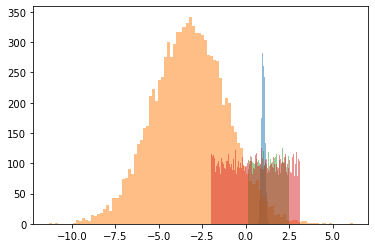Composite priors¶
A common usecase is to have a multidimensional prior with different distributions in each dimension. We achieve this with scipy and torch distributions.
[1]:
%load_ext autoreload
%autoreload 2
[2]:
import torch
import scipy.stats
import numpy as np
import pylab as plt
from toolz import compose
from swyft.prior import Prior, PriorTruncator
from swyft.utils import tensor_to_array, array_to_tensor
Here we define our priors. The parameter_dimensions variable is a list of integers which define the dimensionality of each random variable within the composite.
[3]:
loc = torch.tensor([1.0, -3.2])
scale = torch.tensor([0.1, 2.1])
upper = torch.tensor([2.5, 3.1])
lower = torch.tensor([0.1, -2.0])
parameter_dimensions = [len(loc), len(upper)]
n_parameters = sum(parameter_dimensions)
SciPy Distributions¶
SciPy distributions are simple to use. Put the relevant functions in a list and define the parameter_dimensions value.
[4]:
normal_scipy = scipy.stats.norm(loc, scale)
uniform_scipy = scipy.stats.uniform(lower, upper)
composite_prior_scipy = Prior.composite_prior(
cdfs=[normal_scipy.cdf, uniform_scipy.cdf],
icdfs=[normal_scipy.ppf, uniform_scipy.ppf],
log_probs=[normal_scipy.logpdf, uniform_scipy.logpdf],
parameter_dimensions=parameter_dimensions,
)
[5]:
samples_scipy = PriorTruncator(composite_prior_scipy, bound=None).sample(10_000)
for i in range(n_parameters):
_ = plt.hist(samples_scipy[:, i], bins=100, alpha=0.5)

Torch Distributions¶
This requires the application of Prior.conjugate_tensor_func to convert the numpy arrays to tensors then the output tensors back to numpy arrays. The prior samples and simulations are usually saved as numpy data within swyft, so we must convert to use a pytorch distribution.
We apply Prior.conjugate_tensor_func with a functional idiom.
[6]:
normal = torch.distributions.Normal(loc, scale)
uniform = torch.distributions.Uniform(lower, upper)
composite_prior_torch = Prior.composite_prior(
cdfs=list(map(Prior.conjugate_tensor_func, [normal.cdf, uniform.cdf])),
icdfs=list(map(Prior.conjugate_tensor_func, [normal.icdf, uniform.icdf])),
log_probs=list(map(Prior.conjugate_tensor_func, [normal.log_prob, uniform.log_prob])),
parameter_dimensions=parameter_dimensions,
)
[7]:
samples = PriorTruncator(composite_prior_torch, bound=None).sample(10_000)
for i in range(n_parameters):
_ = plt.hist(samples[:, i], bins=100, alpha=0.5)

Extending¶
Note that the above prior definition is quite flexible. If you want to define your own prior with another system it will work as long as you can specify the cdf, icdf, log_prob, and parameter_dimensions. The most obvious use case would be to define a prior from a variety of packages.
[ ]: